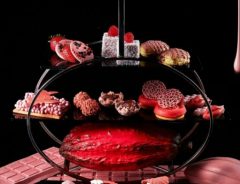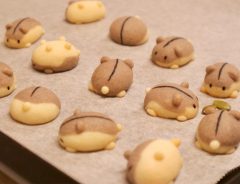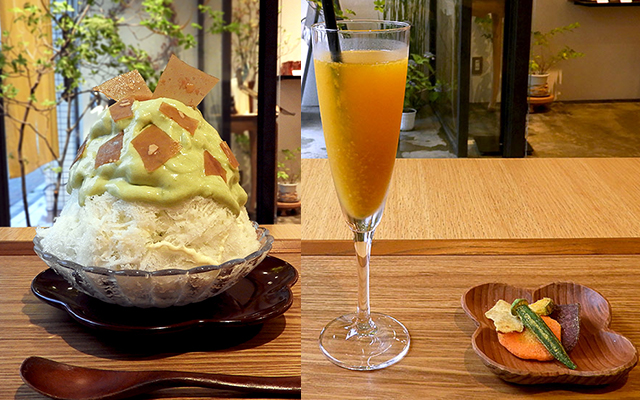- Source:
- © Azabu Yasaigashi
- Tags:
- Azabu Yasaigashi / Dessert / Japanese sweets / Kakigori / Shaved Ice / Summer / summer treats / Sweets / Vegetable / Veggie
Related Article
-

Anime icing artist’s Golden Kamuy macarons may be just too awesome to eat!
-

Tokyo Hotel Offers Luxurious Ruby Chocolate Afternoon Tea
-

Japanese hamster cookies are just too cute to eat!
-

Gudetama brings Easter celebrations to organic doughnut store Floresta
-

Sink Your Fangs into Japan’s Kawaii Halloween All You Can Eat Buffet
-

The Best Destinations in Japan For Each Season: Summer



What is Kakigōri
Kakigōri shaved ice is a must-have summer treat in Japan. Softer and fluffier than American snow cones, with a consistency of freshly fallen snow, kakigōri is traditionally topped with syrups with fruit or other popular flavors and sometimes drizzled with condensed or evaporated milk. Another favorite is ujikintoki, kakigōri with green tea-flavored syrup and sweet red azuki beans on top.
In recent years, the kakigōri market has diversified. Fans of the iced dessert can now indulge in kakigōri which almost rival ice cream parfaits in complexity, for example adding layers of yogurt and chunks of strawberries, or kakigōri using premium ingredients, such as ice from Mt. Fuji with gold leaf on top.
Azabu Yasaigashi
Cafe Space
One cafe in the trendy neighborhood of Azabu Juban in Tokyo has taken kakigōri in a refreshing new direction, replacing the fruit components with vegetables!
The unusual choice of toppings makes sense when you consider that the cafe is situated within Azabu Yasaigashi 麻布 野菜菓子 (vegetable sweets), a charming little shop which offers a wide range of traditional Japanese as well as Western style sweets, cakes, jellies, jams and juices, all of them with vegetables as key ingredients. The cafe has been offering vegetable kakigōri for several years now, with new flavors being added to their selection every year.
Source: © grape Japan
Source: © grape Japan
Vegetable Kakigōri
Source: © grape Japan
AVOCADO (1,000 JPY)
Source: © grape Japan
The first flavor we tried was avocado, available between May and mid-July. Topped with a rich and fluffy sauce blending avocado with fresh cream and lemon, and decorated with slivers of almond caramel, it also contains condensed milk and a cream cheese sauce within the soft shaved ice underneath. But avocado? You may still have reservations about a desert flavored with the typical guacamole ingredient but this surprising dessert tastes actually tastes like bananas, so you're in for a treat.
MINI TOMATO (1,000 JPY)
Source: © grape Japan
Next, we tried mini tomato, available between May and mid-September. Some tomatoes have a surprisingly high sugar level, so it doesn't sound too far-fetched to imagine it being turned into a dessert. And after trying it, we feel it's a resounding success. Topped with a sweet sauce made with fresh mini tomatoes, and blended with cream cheese and condensed milk, this kakigōri is refreshing and delicious.
SPINACH AND MATCHA (1,000 JPY)
Source: © grape Japan
Spinach in a dessert? Before you thumb your nose at the idea, consider how spinach is featured in this dessert. First, the leaves of soft and flavorful spinach from Miyazaki Prefecture are dried and pulverized, then they are added to powdered matcha from the famed Tsujiriichi Tea Shop in Kyoto. Finally, the two powders are blended to make a syrup. Azabu Yasaigashi's kakigōri is a version of the traditional ujikintoki matcha and azuki bean recipe, with their spinach-matcha syrup used instead. Try it and you'll be in for a pleasant surprise. The spinach flavor is present just subtly enough to provide an interesting accent to the strong matcha flavor, creating a new and even healthier version of a beloved classic.
Other menu items
ANMITSU (850 JPY)
Source: © grape Japan
New for 2018, Azabu Yasaigashi's version of anmitsu, a traditional Japanese dessert, contains kanten jelly flavored with Banbara Tea, a paste made with mildly sweet purple yams and gyuhi mochi fashioned into cute shapes, resting on a compote of mini tomatoes and hōzuki cherries.
HOZUKI CHERRY JUICE (500 JPY)
Source: © grape Japan
Speaking of hōzuki cherries, we also highly recommend their fresh hōzuki cherry juice, which had a perfect blend of tartness and sweetness with a hint of mango. The juice is served with a plate of Azabu Yasaigashi's popular vegetable chips. Paired with the hōzuki cherry juice was their curry flavored blend.
Shop
Once you've enjoyed vegetable kakigōri at the cafe, you'll want to explore the delicious options at the shop, all of which make great gifts.
Source: © grape Japan
One of their more recent additions to their lineup, these are vegetable financiers, available in tomato, spinach and green tea, pumpkin, purple sweet potato, ginger and burdock.
Source: © grape Japan
You could also try their vegetable paste dorayaki, sweet vegetable paste filling sandwiched between two small pancakes, available in organic red bean, purple sweet potato and pumpkin, or their vegetable monaka, sweet vegetable paste filling sandwiches between two rice wafers topped with sliced vegetable, available in sweet potato, black sesame and lotus root.
Other tempting options in the shop are yokan, mizuyokan, vegetable jellies, pound cakes, bean snacks, or the abovementioned vegetable chips, as well as a selection of juices. To see the complete selection and purchase online, visit their homepage here (in Japanese).
Source: © grape Japan
Source: © grape Japan
Other vegetable kakigori: Summer-Fall 2018 Schedule
Unfortunately, we couldn't try all of the wonderful vegetable kakigōri varieties, and some of them are available at different times during the summer. Here is the full list and approximate schedule:
Source: © grape Japan
Fig (June to mid-September)
Source: © grape Japan
Hōzuki Cherry (May to mid-September)
Source: © grape Japan
Pumpkin (July to mid-August)
Source: © grape Japan
Celery (July to mid-August)
Source: © grape Japan
Lemon (August)
Source: © grape Japan
Brown sugar and ginger (August to mid-September)
Azabu Yasaigashi Information